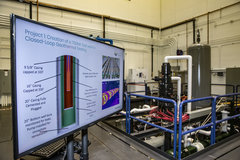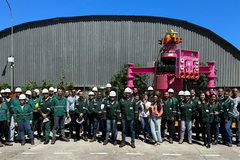Rod Christie, Executive Vice President of Turbomachinery & Process Solutions wants you to know the oil and gas industry is serious about climate change.
There’s an enormous amount of investment going into developing and refining the technological solutions the world needs to meet the CO2 emissions-reduction targets of the Paris Climate Accord in order to limit global warming. All the same, says Rod Christie, Executive Vice President of Turbomachinery & Process Solutions (TPS) at Baker Hughes, “If I’m brutally honest, from an industry awareness perspective, there’s a long way to go.”
“If I’m brutally honest, from an industry awareness perspective, there’s a long way to go.”
Such forthrightness is the only way to confront the urgency of climate change. “The science is so clear on global warming, and just curtailing what we do today is not going to have a big enough impact to stop it,” says Christie. “All the lockdowns this year have shown us that nature will respond to us cutting carbon. The question is: Can we get our act together to actually do it?”
Whether it’s driven by concern for the environment or protecting the long-term future of a sector that’s under increased scrutiny from shareholders and financial analysts, Christie says he sees leadership across the oil and gas industry “waking up to the fact that we need to do something different”.
One of the challenges he sees for his industry is that “we’ve traditionally been a very bad manager of our own message”. He points to “the positive global impact of the oil and gas industry: Bringing people out of poverty, creating industries, developing technologies … it’s hard to think of another industry that’s done as much for society.” It’s an inescapable fact, however, “that using our raw products creates a lot of carbon, and when you ask the public, ‘What's the oil and gas industry done?’, most will tell you, ‘Polluted the world!’.”
Christie is as passionate about owning the problem as he is about leading the teams working to bring the solutions. In a world that runs on energy and must lower carbon emissions, the two are interlocked. Christie sees that as a key message for recruiting the talent to keep developing new tools and technologies to reduce emissions.
“Baker Hughes has pivoted to become an energy technology company that provides solutions for decarbonization,” he explains. “Some of that’s physical but it very much also includes digital, such as advanced analytics and artificial intelligence to optimize equipment and the efficiency of an operation. For me, that’s hugely compelling for anyone coming out of university.”

As head of TPS, Christie is based at the largest Baker Hughes facility in Florence, Italy and has aspirations for it to become a Silicon Valley for energy technology development. “Here we are a major technology innovator and leader in decarbonization technologies generally, as well as some very specific ones including combustion, compression, additive and advanced materials,” he says. “That attracts talent from around the globe – people who want to be part of that solution. You could go and create apps for ordering pizza online or things like that, or you can be involved in creating applications and technology which address a major issue for the world: decarbonization and global warming.”
He says at employees all-hands meetings, quarterly KPIs for the business are obviously a focus for the team, but “when we talk about how we are driving technologies that will help our industry drive more decarbonization and adopt more alternative energy including carbon capture and storage, hydrogen and other environmental technologies and programs – that’s when the energy level spikes in the room.”
Baker Hughes has just been named a member of the Hydrogen Council, which launched during the World Economic Forum in 2017 as a global initiative of leading energy, transport and industry companies working to foster hydrogen’s role in the world’s energy transition. Christie says there’s work ahead to make hydrogen a significant alternative energy solution, including the economics of production and also the high levels of NOx – nitrous oxide emissions produced from hydrogen combustion. “That’s something that gives you other problems, such as acid rain and health issues.”
This July, Baker Hughes announced it had completed a trial at the Florence facility of the world’s first hybrid hydrogen turbine – which operates on a blend of natural gas and hydrogen – in collaboration with Italian-headquartered energy infrastructure giant Snam. “This ability to blend different mixes of natural gas and hydrogen is one of the technologies that will help bring stable combustion with lower levels of NOx,” says Christie. The successful trial was an important milestone for both companies: of Snam’s 41,000km gas transmission network, 70% of the pipes are already ‘hydrogen ready’.
“The last piece of the jigsaw for hydrogen is materials science,” says Christie, explaining the problem of hydrogen embrittlement, where over time the gas gets into materials, including metal, creating micro-cracks. “You basically end up with the material failing.”
Baker Hughes is developing the science and technology to help clear all three hydrogen hurdles Christie has described. This isn’t a recent development. “We’ve been actively working on hydrogen compression since the 1960s and combustion science since 2006 when we first introduced a gas turbine that could run 100% on hydrogen at a gas power plant, and we’re working on new technologies for efficient hydrogen production, such as the generation of green hydrogen as well as on the materials science to solve the embrittlement problem. So, we have hydrogen solutions in focus across a broad range of our technologies.” A long-term commitment and a willingness to invest in developing solutions Christie says is critical. “You have to lead with the conviction that the energy transition will happen and be willing to invest in making it happen.”
Working with partners and customers is essential to meet the energy transition challenge. “One or two companies can lead and drive and push, but there must be much broader product collaboration,” says Christie.
“One or two companies can lead and drive and push, but there must be much broader product collaboration.”
Christie takes his role to heart. “When you come into a leadership position, that’s your baseline,” he says. “When the time comes for you to leave, you want to look back and say, ‘Did I help move the company forward? Is it sustainable? Have we made it a better place than it was when we came in?”
He and his fellow leaders talk openly and often about the urgency of energy transition. “If we continue to do what we have done for the past decades, we’re not doing the right thing by anyone,” he says. “We have people joining the company today who will hopefully create their career with us, and we must set up the business for success in the future. Creating these decarbonization solutions and technologies to keep the business vibrant 30 years and beyond is the socially responsible thing to do for our employees, our shareholders, the community and our industry. We want whoever follows us – and those who follow the people who follow us – to look back and say, ‘Thank god they made those decisions when they did, because if they hadn’t, we would have a very different business. ”
For more information about Low Carbon solutions, visit the new capabilities page.
Energy Forward Stories
Sign up to stay up to date on the latest innovations and people shaping the future of our industry.




